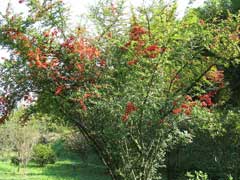 |
|
http://commons.wikimedia.org/wiki/User:Brosen |
 |
| http://commons.wikimedia.org/wiki/User:KENPEI |
Translate this page:
Summary
Bloom Color: White. Main Bloom Time: Late spring, Mid spring. Form: Rounded, Spreading or horizontal, Vase.
Physical Characteristics

 Pyracantha coccinea is an evergreen Shrub growing to 4 m (13ft) by 4 m (13ft) at a fast rate.
Pyracantha coccinea is an evergreen Shrub growing to 4 m (13ft) by 4 m (13ft) at a fast rate.
See above for USDA hardiness. It is hardy to UK zone 6. It is in leaf all year, in flower in June. The species is hermaphrodite (has both male and female organs) and is pollinated by Bees.
It is noted for attracting wildlife.
Suitable for: light (sandy), medium (loamy) and heavy (clay) soils, prefers well-drained soil and can grow in heavy clay soil. Suitable pH: mildly acid, neutral and basic (mildly alkaline) soils and can grow in very alkaline soils.
It can grow in full shade (deep woodland) semi-shade (light woodland) or no shade. It prefers moist soil. The plant can tolerates strong winds but not maritime exposure.
It can tolerate atmospheric pollution.
UK Hardiness Map
US Hardiness Map
Synonyms
Cotoneaster pyracantha. Crataegus pyracantha. Mespilus pyracantha.
Plant Habitats
Woodland Garden Dappled Shade; Shady Edge; not Deep Shade; Hedge;
Edible Uses
Edible Parts: Fruit
Edible Uses:
Fruit - cooked. Used for making jellies, marmalade and sauces[15, 183].
References More on Edible Uses
Medicinal Uses
Plants For A Future can not take any responsibility for any adverse effects from the use of plants. Always seek advice from a professional before using a plant medicinally.
None known
References More on Medicinal Uses
The Bookshop: Edible Plant Books
Our Latest books on Perennial Plants For Food Forests and Permaculture Gardens in paperback or digital formats.

Edible Tropical Plants
Food Forest Plants for Hotter Conditions: 250+ Plants For Tropical Food Forests & Permaculture Gardens.
More

Edible Temperate Plants
Plants for Your Food Forest: 500 Plants for Temperate Food Forests & Permaculture Gardens.
More

More Books
PFAF have eight books available in paperback and digital formats. Browse the shop for more information.
Shop Now
Other Uses
Hedge Hedge
Landscape Uses: Erosion control, Espalier, Massing, Seashore. Tolerant of trimming and of reasonable exposure, it can be grown as a hedge[49, 200]. It forms a very spiny barrier[200].
Special Uses
Attracts Wildlife Espalier Hedge Hedge
References More on Other Uses
Cultivation details
Prefers a good well-drained, moisture-retentive loamy soil[1, 200]. Succeeds in any soil that is warm and not very heavy[11]. Another report says that it grows well in heavy clay soils. Succeeds on chalky soils[108]. Succeeds in sun or part shade[200] and also on a shady wall[28, 49], though it does not fruit so well in a shady position[200]. Tolerates atmospheric pollution and reasonable exposure[200]. A very ornamental plant[1], there are a number of named varieties[11, 200]. Susceptible to scab and fireblight[11], especially when grown on acid sandy soils[182]. This species, especially the cultivar 'Lelandii', is notably resistant to honey fungus[200]. Intolerant of root disturbance except when young[11]. A good bee plant[108]. Birds are particularly attracted to the fruit of this plant[200]. Special Features:Not North American native, Attractive flowers or blooms.
References Carbon Farming Information and Carbon Sequestration Information
Temperature Converter
Type a value in the Celsius field to convert the value to Fahrenheit:
Fahrenheit:
The PFAF Bookshop
Plants For A Future have a number of books available in paperback and digital form. Book titles include Edible Plants, Edible Perennials, Edible Trees,Edible Shrubs, Woodland Gardening, and Temperate Food Forest Plants. Our new book is Food Forest Plants For Hotter Conditions (Tropical and Sub-Tropical).
Shop Now
Plant Propagation
Seed - best sown as soon as it is ripe in a cold frame[200]. Remove all the fruit flesh since this can inhibit germination[200]. Stored seed requires 3 months cold stratification, sow it as early in the year as possible in a cold frame[113]. When they are large enough to handle, prick the seedlings out into individual pots and grow them on in the cold frame for their first winter. Plant them out into their permanent positions in late spring or early summer, after the last expected frosts. Cuttings of almost mature wood, 5 - 10cm with a heel, mid-August in a cold frame[78]. Pot up in October or the following spring[78].
Other Names
If available other names are mentioned here
Native Range
TEMPERATE ASIA: Iran (north), Lebanon, Syria, Turkey, Armenia, Azerbaijan, Georgia EUROPE: Switzerland, Czech Republic, Slovakia, Ukraine (Krym), Albania, Bulgaria, Greece, Croatia, North Macedonia, Montenegro, Spain (northeast), France (south)
Weed Potential
Right plant wrong place. We are currently updating this section.
Please note that a plant may be invasive in one area but may not in your area so it's worth checking.
Conservation Status
IUCN Red List of Threatened Plants Status :

Growth: S = slow M = medium F = fast. Soil: L = light (sandy) M = medium H = heavy (clay). pH: A = acid N = neutral B = basic (alkaline). Shade: F = full shade S = semi-shade N = no shade. Moisture: D = dry M = Moist We = wet Wa = water.
Now available:
Food Forest Plants for Mediterranean Conditions
350+ Perennial Plants For Mediterranean and Drier Food Forests and Permaculture Gardens.
[Paperback and eBook]
This is the third in Plants For A Future's series of plant guides for food forests tailored to
specific climate zones. Following volumes on temperate and tropical ecosystems, this book focuses
on species suited to Mediterranean conditions—regions with hot, dry summers and cool, wet winters,
often facing the added challenge of climate change.
Read More
Expert comment
Author
M.J.Roem.
Botanical References
1189200
Links / References
For a list of references used on this page please go here
Readers comment